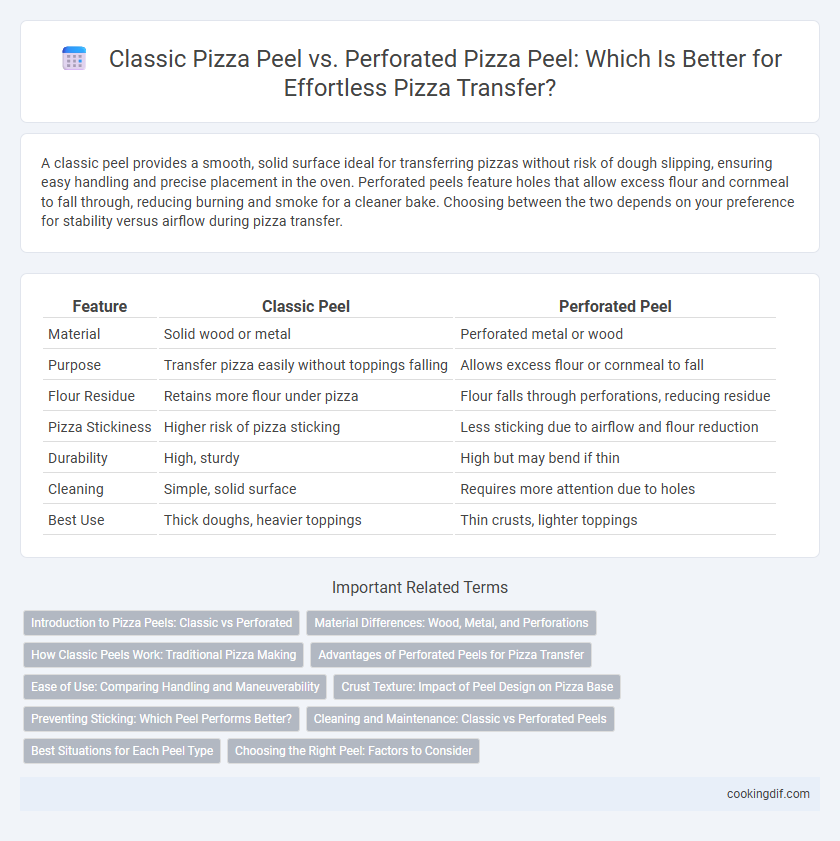A classic peel provides a smooth, solid surface ideal for transferring pizzas without risk of dough slipping, ensuring easy handling and precise placement in the oven. Perforated peels feature holes that allow excess flour and cornmeal to fall through, reducing burning and smoke for a cleaner bake. Choosing between the two depends on your preference for stability versus airflow during pizza transfer.
Table of Comparison
| Feature | Classic Peel | Perforated Peel |
|---|---|---|
| Material | Solid wood or metal | Perforated metal or wood |
| Purpose | Transfer pizza easily without toppings falling | Allows excess flour or cornmeal to fall |
| Flour Residue | Retains more flour under pizza | Flour falls through perforations, reducing residue |
| Pizza Stickiness | Higher risk of pizza sticking | Less sticking due to airflow and flour reduction |
| Durability | High, sturdy | High but may bend if thin |
| Cleaning | Simple, solid surface | Requires more attention due to holes |
| Best Use | Thick doughs, heavier toppings | Thin crusts, lighter toppings |
Introduction to Pizza Peels: Classic vs Perforated
Classic pizza peels, typically made of wood or metal, provide a solid surface for transferring pizza dough and toppings into the oven, ensuring stability and ease of use. Perforated peels feature holes or slots that reduce dough sticking by allowing excess flour to fall through, resulting in a crispier crust and less residue on the peel. Choosing between classic and perforated peels depends on the desired handling experience and crust texture preferences.
Material Differences: Wood, Metal, and Perforations
Wooden classic peels offer a traditional, non-stick surface ideal for transferring pizza dough without tearing, while metal peels provide durability and a thin edge for easy sliding under pies. Perforated metal peels reduce excess flour buildup by allowing it to fall through, enhancing crispness and preventing sogginess on the pizza base. Choosing between wood and metal depends on handling preference and maintenance, with perforated options improving airflow and reducing sticking during transfer.
How Classic Peels Work: Traditional Pizza Making
Classic peels, typically made of solid wood or metal, provide a sturdy, flat surface for transferring pizza dough into and out of hot ovens, ensuring even support during baking. Their smooth, solid design prevents the dough from sticking, allowing for precise maneuvering and easy retrieval of fully cooked pizzas. Unlike perforated peels, classic peels are ideal for thicker crusts and traditional pizza styles that require stable handling without dough falling through holes.
Advantages of Perforated Peels for Pizza Transfer
Perforated pizza peels offer superior airflow, preventing dough from sticking by allowing excess flour to escape during transfer. Their lightweight design enhances maneuverability, providing precise control when sliding the pizza onto the oven surface. These advantages result in a crispier crust and a more efficient pizza transfer process compared to classic solid peels.
Ease of Use: Comparing Handling and Maneuverability
Classic pizza peels feature a solid, flat surface that provides stable support when transferring dough or cooked pizza, making handling straightforward but sometimes cumbersome with heavier pies. Perforated peels offer enhanced maneuverability due to their lightweight design and holes that reduce dough sticking, allowing easier shaking and release during transfer. The choice between classic and perforated peels hinges on balancing sturdiness and ease of use, with perforated peels favored for quick, precise handling in fast-paced pizza preparation.
Crust Texture: Impact of Peel Design on Pizza Base
Classic pizza peels with solid surfaces provide a consistent, even support that helps maintain a uniform crust texture by preventing dough sagging during transfer. Perforated peels improve airflow and reduce moisture buildup, resulting in a crisper crust edge by allowing steam to escape more efficiently. Choice of peel design directly influences the balance between a sturdy base and a crunchy perimeter, essential for achieving the desired pizza crust texture.
Preventing Sticking: Which Peel Performs Better?
Classic pizza peels feature a solid, flat surface that provides consistent support when transferring dough and finished pizzas, but can sometimes cause sticking if the crust or peel is not properly floured. Perforated peels, designed with holes or slots, allow excess flour and cornmeal to fall through, reducing the risk of dough sticking during transfer and promoting better airflow under the pizza. For preventing sticking specifically, perforated peels generally perform better by minimizing moisture buildup and ensuring a smoother release of the pizza onto the oven surface.
Cleaning and Maintenance: Classic vs Perforated Peels
Classic pizza peels feature a solid wooden or metal surface that is easier to clean and maintain, as food particles and dough residues do not get trapped. Perforated peels, with their holes designed to release excess flour, require more thorough cleaning to remove trapped dough and toppings, increasing maintenance time. Choosing a classic peel simplifies cleaning routines and reduces wear from frequent scrubbing, making it preferable for consistent kitchen hygiene.
Best Situations for Each Peel Type
A classic pizza peel, typically made from wood or metal, is best suited for transferring raw dough onto a hot stone or oven surface, providing a solid base that prevents sticking and allows precise placement. Perforated peels, featuring holes or slots, excel at removing cooked pizzas from the oven by minimizing dough adhesion and reducing excess flour transfer, ensuring a crispier crust. Use a classic peel for loading raw pizzas and a perforated peel for retrieving finished pies to optimize handling and pizza quality.
Choosing the Right Peel: Factors to Consider
Choosing the right pizza peel depends on factors such as dough texture, transfer precision, and cooking surface. Classic peels, typically made of wood or metal, offer a solid base ideal for thicker, traditional doughs, preventing sticking during transfer. Perforated peels feature holes that reduce flour buildup and allow excess cornmeal to fall away, enhancing slip and crispiness, especially suited for thin-crust pizzas and high-temperature stone ovens.
Classic peel vs Perforated peel for pizza transfer Infographic

 cookingdif.com
cookingdif.com